“The math should matter.”
A brief quote taken from The Athletic’s interview of Los Angeles Chargers coach, Brandon Staley, struck Ian Sarachan and Aidan Reynolds.
Assistant coaches for Creighton University in the American NCAA, the long-time friends latched onto the line and created a theme.
The math should matter, especially for this Creighton team. In an NCAA soccer scene that has been a slow adapter to data analytics, the Creighton coaching staff found their secret weapon. Head coach Johnny Torres wanted something different, something that connected to his love of attacking football and high pressing. Investing in data analytics was the answer, both for the coaches and the players. “We really wanted to grow the minds of our players. To do that, we motivated them in so many different ways, and a lot of it was through the use of data,” said Reynolds.
This data analysis is the product of a two-hour conversation with Sarachan, who’s still at Creighton, and Reynolds, who now works for St. Louis City FC, the Western Conference leaders in MLS in their inaugural season (there may be something to the analytics angle). Without entirely pulling the curtain on the Creighton project, the two were kind enough to offer insights into some of the program’s core focuses in their data analysis project and reveal the foundational principles of the team’s game model.
The insights into the project were fascinating, as were connecting the details of the conversation to Wyscout data and film. For the unversed, Creighton’s 2022 season ended in the NCAA Final Four, the national semifinal at the highest level of NCAA soccer. In other words, they were 3rd out of 212 teams.
Let’s go behind the scenes. This is 2022 Creighton’s story.
Field Tilt
To give some context, this is a Creighton side that lost two critical pieces from the 2021 squad. In previewing Creighton’s 2022 prospects, College Soccer News pointed to goals as a potential issue for the squad: “The departure of forwards Diego Gutierrez (10g, 7a) and Manu Toledano (6g, 0a) means that the Bluejays will be without their top two goalscorers from the 2021 team…Creighton has the talent and experience needed to move upward in the highly competitive Big East Conference and return to the NCAA Tournament field if, and that is a big if, lack of offensive firepower doesn’t become a factor.” The coaching staff read that quote to the players during the first preseason meeting. The second time they addressed it? During the Elite 8 prematch presentation, as they prepared for Duke. At that point, they were the nation’s top-scoring team.
The vision was there from the start. Torres wanted his Creighton side to bring his ideas of an attack-oriented brand with an intense press to life. That was really the starting point of this data analytics project. Sarachan and Reynolds were tasked with taking the team’s game model and determining the program’s KPIs.
The two assistant coaches had to develop a means of tracking possession dominance to build an attacking juggernaut. Field tilt immediately came to mind, but they weren’t satisfied with defining the metric based on final third touches. It didn’t fully capture the team’s ideals and ambitions. While taking the basic concept of field tilt, they created an equation centred on touches in the box. To Sarachan and Reynolds, it was those specific touches that better represented their side’s level of dominance in a game.
“Field tilt became a big one, especially how we were measuring it. It was how we determined the most effective ways to create chances. Obviously, that was about being in the final third, and more specifically, in the box looking for cutbacks and these sorts of things, so field tilt became an important metric to quantify how often we were doing that. Over the course of the season, we got to see how that trended.” – Sarachan.
Looking at data from the fall 2022 season, Creighton was in a league of their own in terms of touches in the penalty area P90 and among the national leaders in shots P90. Unsurprisingly, they also led the nation with 65 goals in 24 matches, a 2.71 goals per game average.
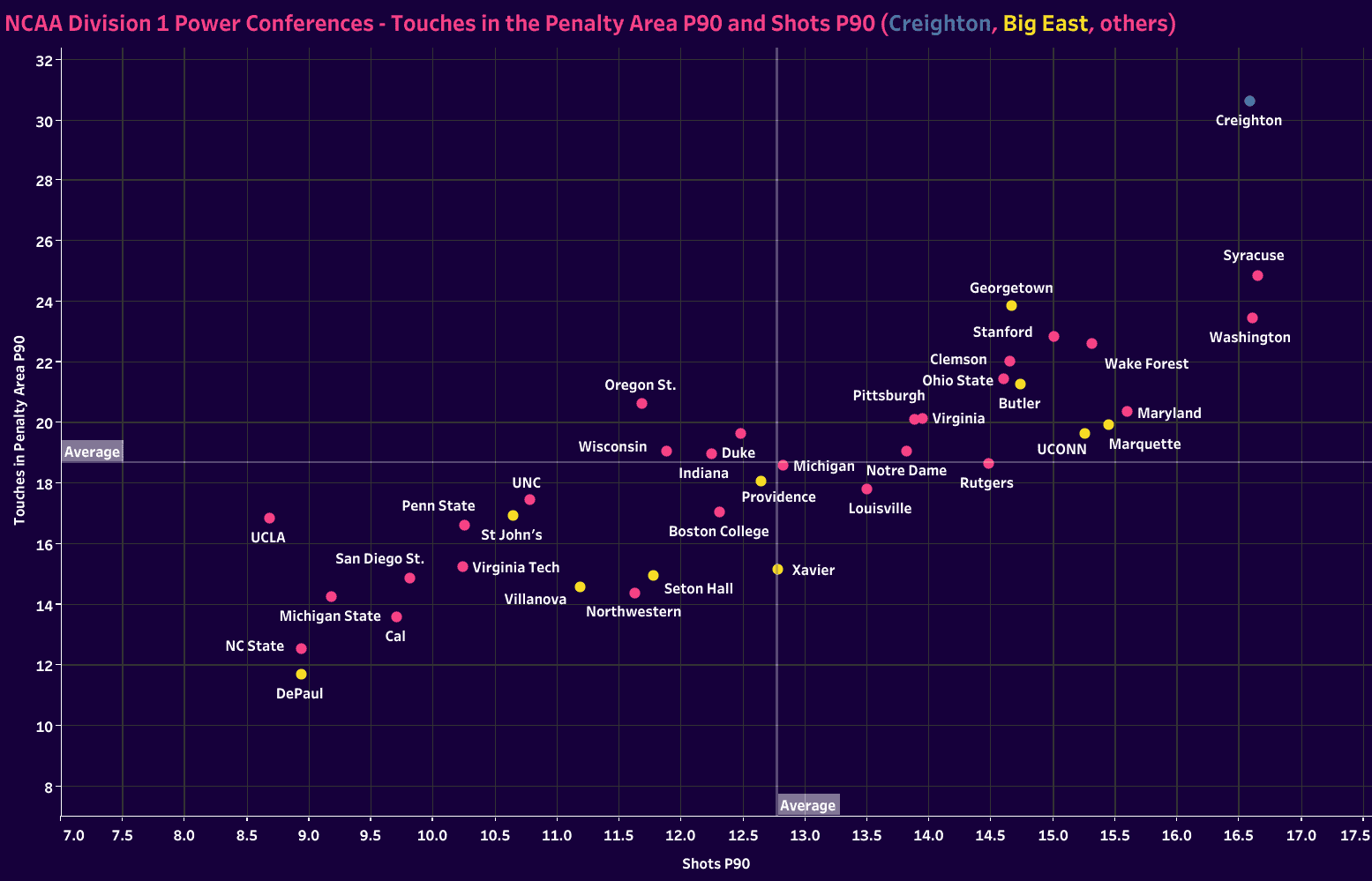
While it was the touches in the box that were of the utmost importance, it was the plethora of ways that Creighton entered the penalty area that kept opponents off balance. They could just as easily play over the top to Duncan McGuire, who now shares a stage with former Barcelona and PSG star Lionel Messi in MLS, or they could simply create wide overloads and act based on what the opponent was showing them.
Against Oakland University in the opening game, a 3v3 wide overload allowed the São Miguel, Portugal native Miguel Ventura to whip in a cross to McGuire at the far post. Notice that it’s not just McGuire waiting for the service. Creighton has a 3v3 out wide, preparing to serve a cross into any one of four teammates in or near the box. Those numbers in threatening areas were pivotal to Creighton’s success.
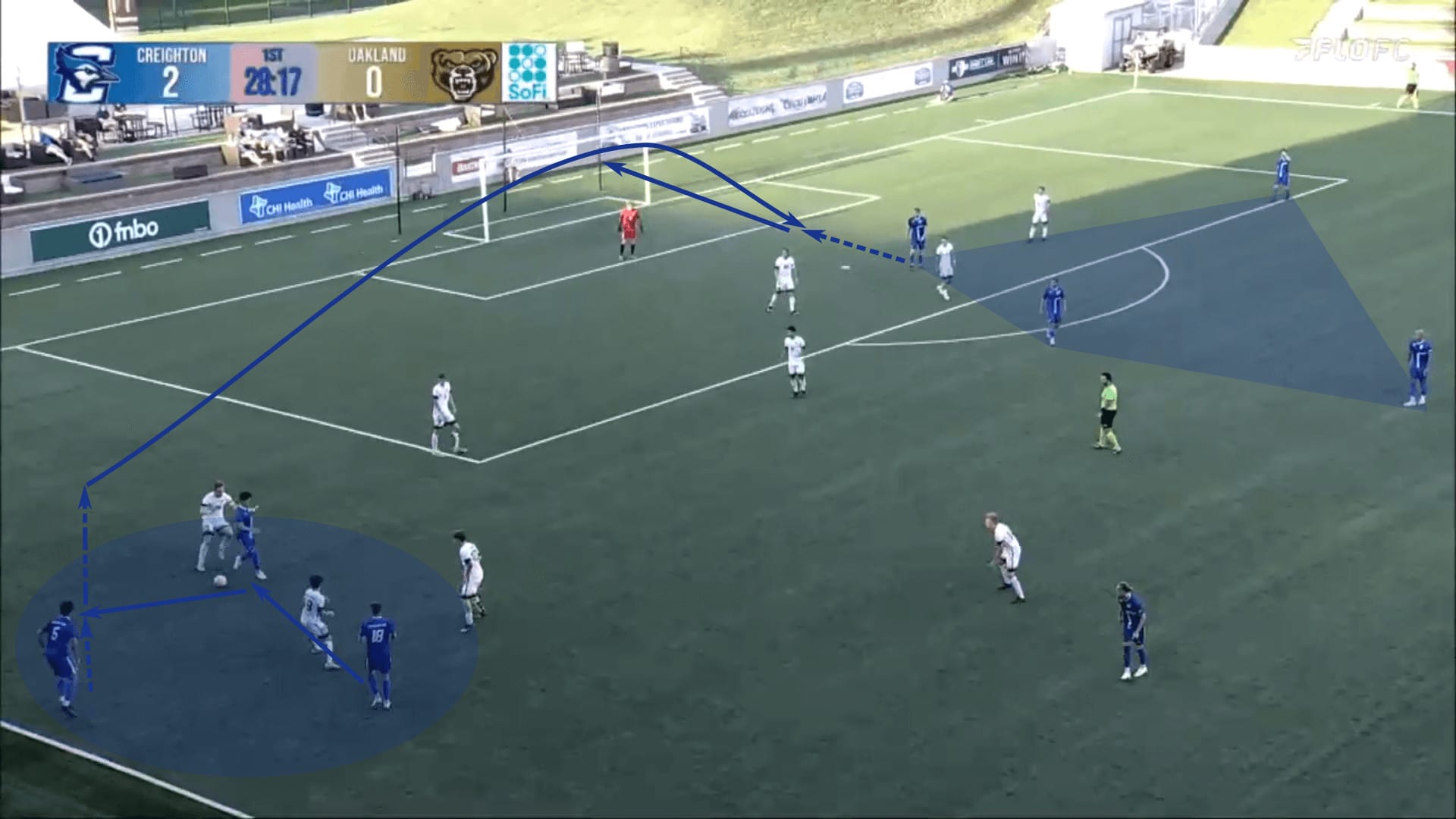
Watching each of their goals from that Cinderella run of fall 2022, one very noticeable theme was a high central presence as they looked to attack the box. Since touches in the box were a priority, attacking the box with numbers was a necessity.
Having the high central numbers opens up so many options for Creighton. Against Seton Hall, they were able to send an early cross from the right half-space for a Jackson Castro goal.
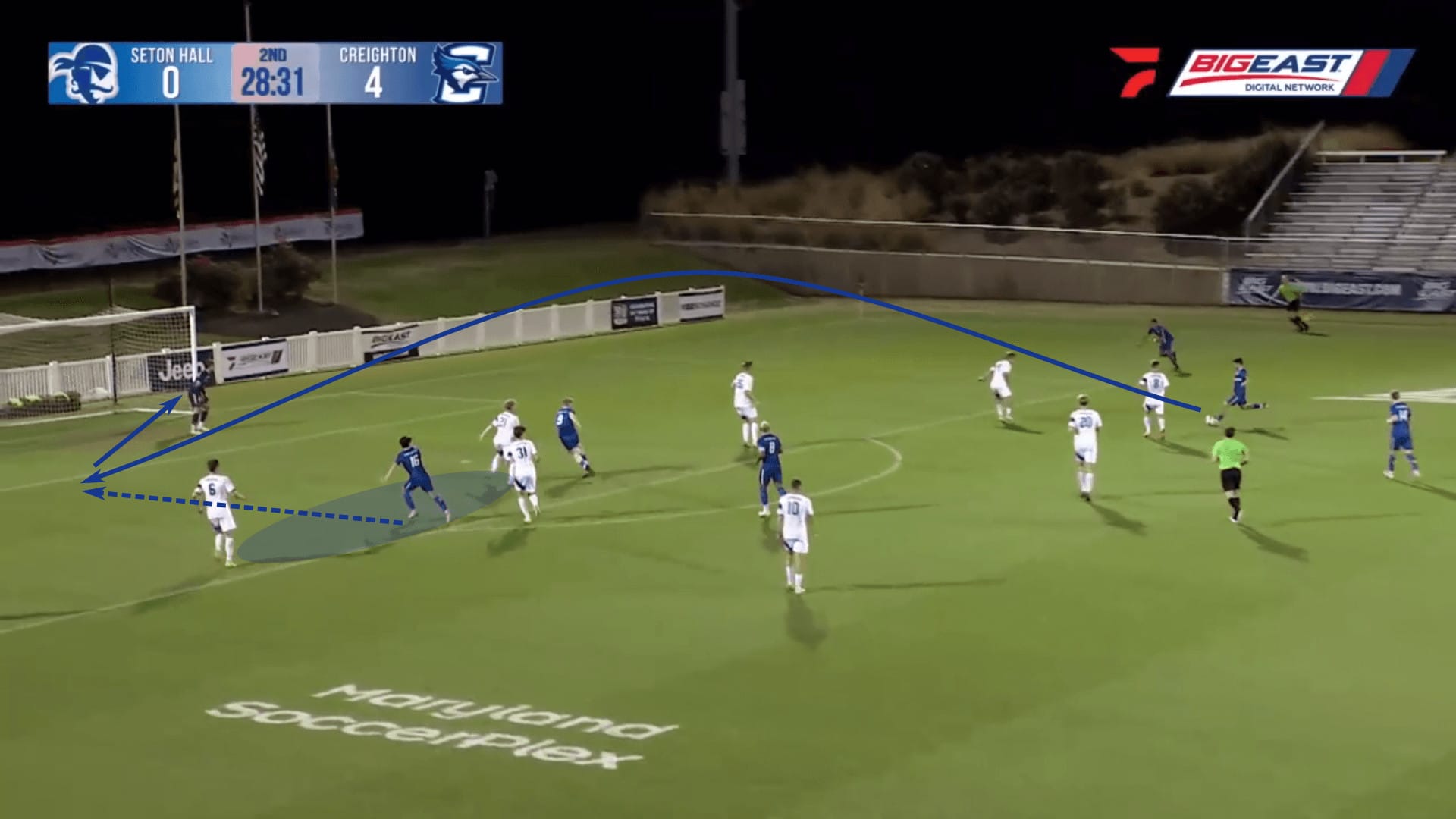
In the NCAA National tournament against Missouri State, the game-winner came from a quick central combination culminating in Giorgio Probo sending Alejandro Maillet to the penalty spot for the game-winner with less than three minutes remaining on the clock.
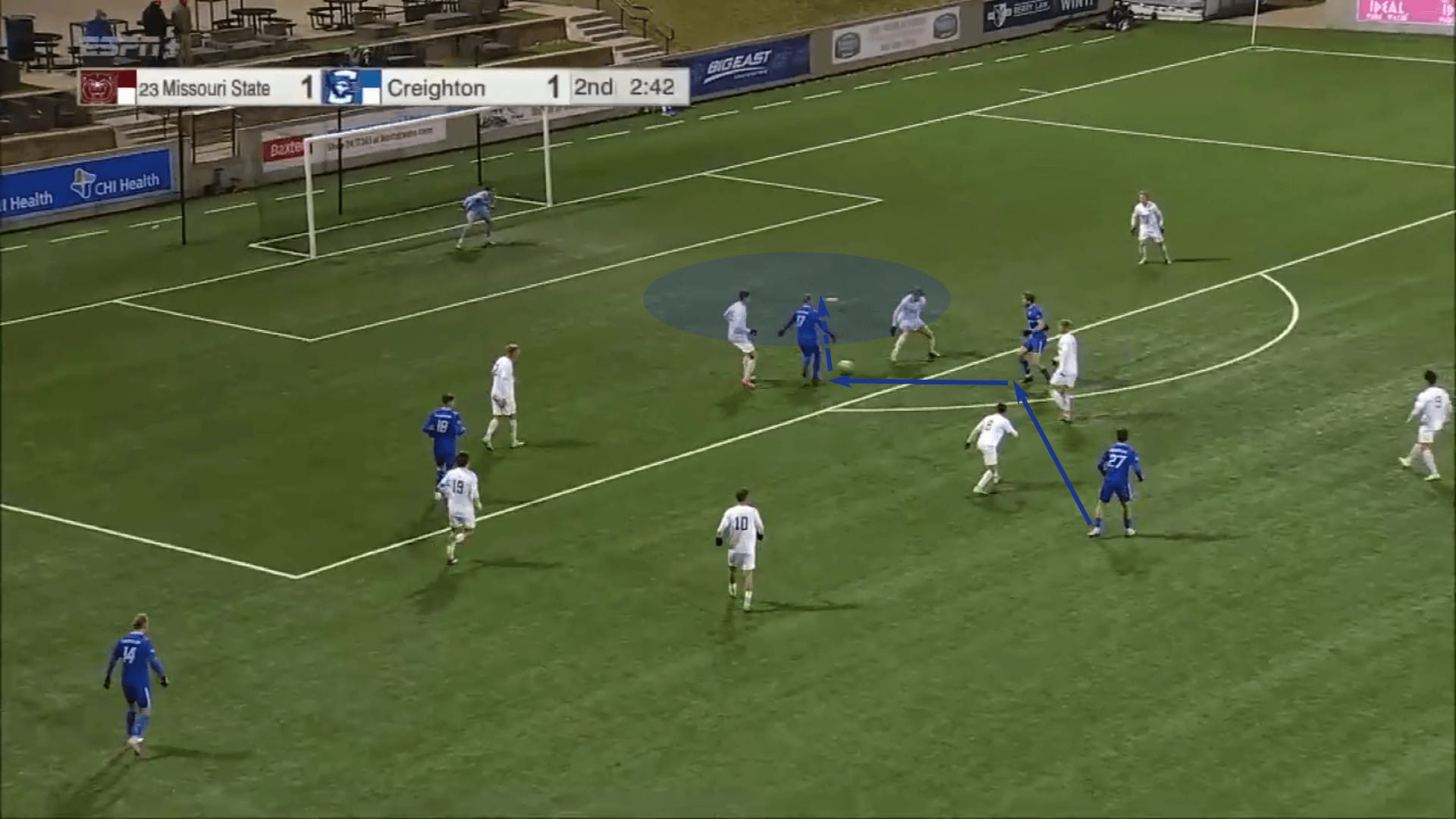
One of the difficulties in defending this Creighton side was their ability to attack the box through various means. The first two examples came from crosses, and the last one from a central combination. Stanford fell victim to one of Creighton’s top goals in the season.
Through a combination of well-connected passing and decoy runs to drive the Stanford backline closer to their goal, Creighton found their way centrally with a pass into the right half-space. That pass drew defenders towards the ball, but then a second pass into the right half-space, this time to Charles Auguste, who held a deeper position, pulled the Stanford defenders away from the central channel.
Once Castro received the ball at the top of the box, all that was left was the shot on goal. The Texas native delivered with a beautiful bending shot tucked into the top corner of the near post. Creighton had their draw against a perennial powerhouse.
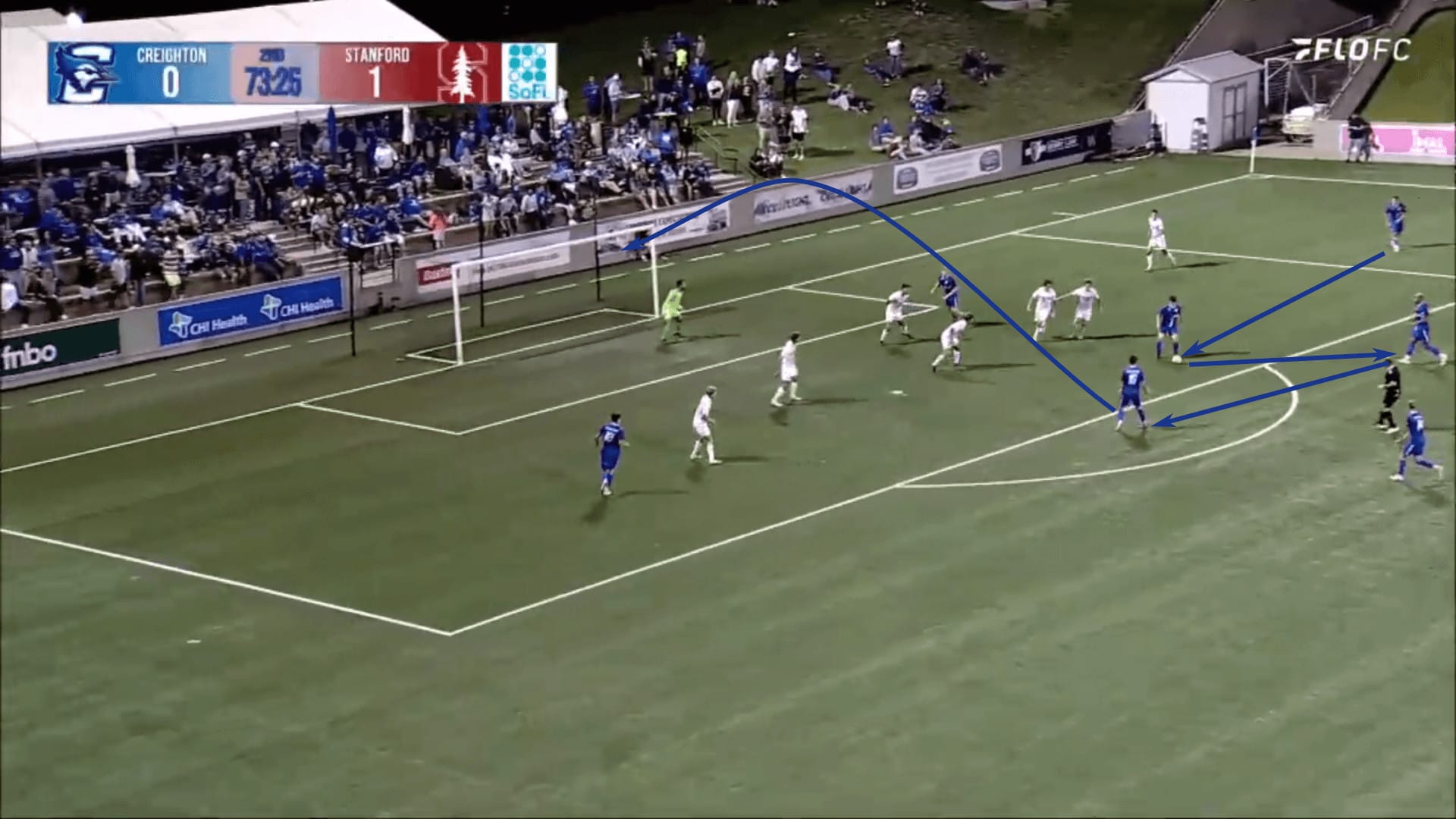
Throughout our conversation, cut-back crosses were mentioned several times. Mathematically, they’re the superior option to crosses from wide areas. Though McGuire found himself on the end of many of those crosses, the Orlando City forward also played a pivotal role in creating space for his teammates.
The 23-goal scorer commanded the attention of the opponent’s backline with his near-post runs, often freeing up the negative cross to the penalty spot. His runs, rewarded or not, provided that immediate threat that opponents had to nullify. That action created opportunities not only for himself but for his teammates as well.
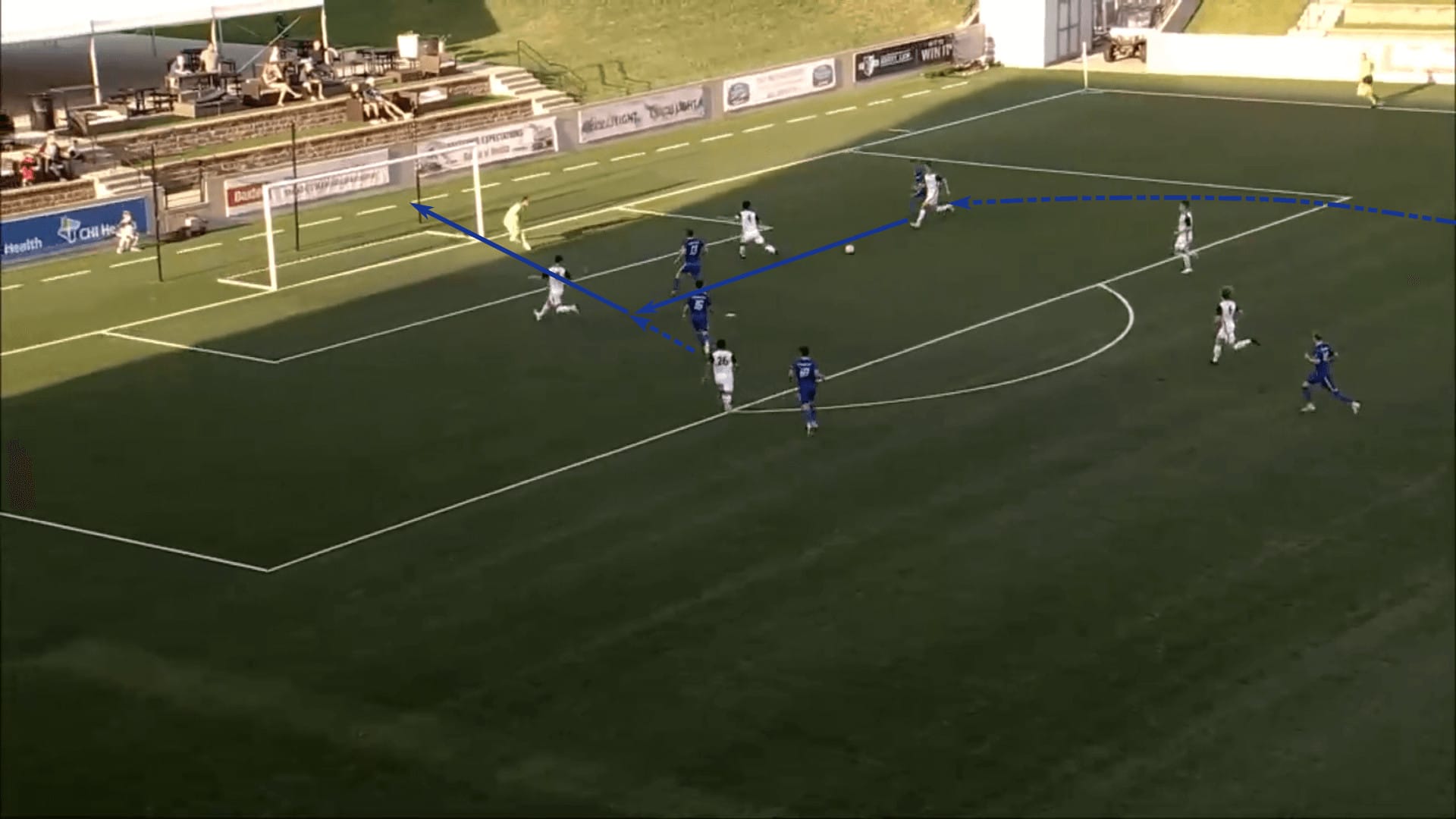
The last note of the section is just how frequently Creighton’s wingbacks look to turn the corner and drive into the box. Like in this previous example, a successful 1v1 duel allowed the Bluejays to attack the box under complete control and with multiple options. That patience and intelligence to attack the right opportunities paid dividends. As Creighton attacked the box, they frequently left opponents scrambling to account for runners and contend with the threat of the first attacker to get to goal.
Sarachan’s presentations linked each phase of play to attacking opportunities the team would encounter, and Reynolds’ detailing of the values of attacking actions resonated with this team. They knew where teammates would be and how opponents would respond and showed a collective awareness of which spaces would help them reach the box together. Watching each of the 65 goals, there’s little mystery as to why they led the nation in goals scored in 2022. The collective understanding was a massive advantage.
xG and xG per shot
There’s a right way and a wrong way to use xG. Small sample sizes to determine the superiority of a side in a singular match is one of the pet peeves of many analysts. So is the lack of correlation between the xG in a given game relative to the number of shots taken or saying that Team X should have beaten Team Y simply because of the xG outcomes? Frequently, the stat is used as a little more than conjecture and a means of stating why the teams we support should have won over the weekend.
Within a club or team setting, xG is a fantastic tool for framing shot quality. I can’t admit to identifying Creighton’s shot selection patterns prior to their data analytics movement, but what I can say is that the coaching staff believes framing shot quality in a mathematical language improved their players’ shot selection. “It wasn’t the end-all-be-all, but the use of xG for determining shot value, which decreased shot distance, was a huge one for us,” said Sarachan.
No one averaged a higher xG P90 among the power conference schools than Creighton. Few of the schools on the list could match their xG per shot value, either. The end result was a team with a high shot volume and even better shot quality.
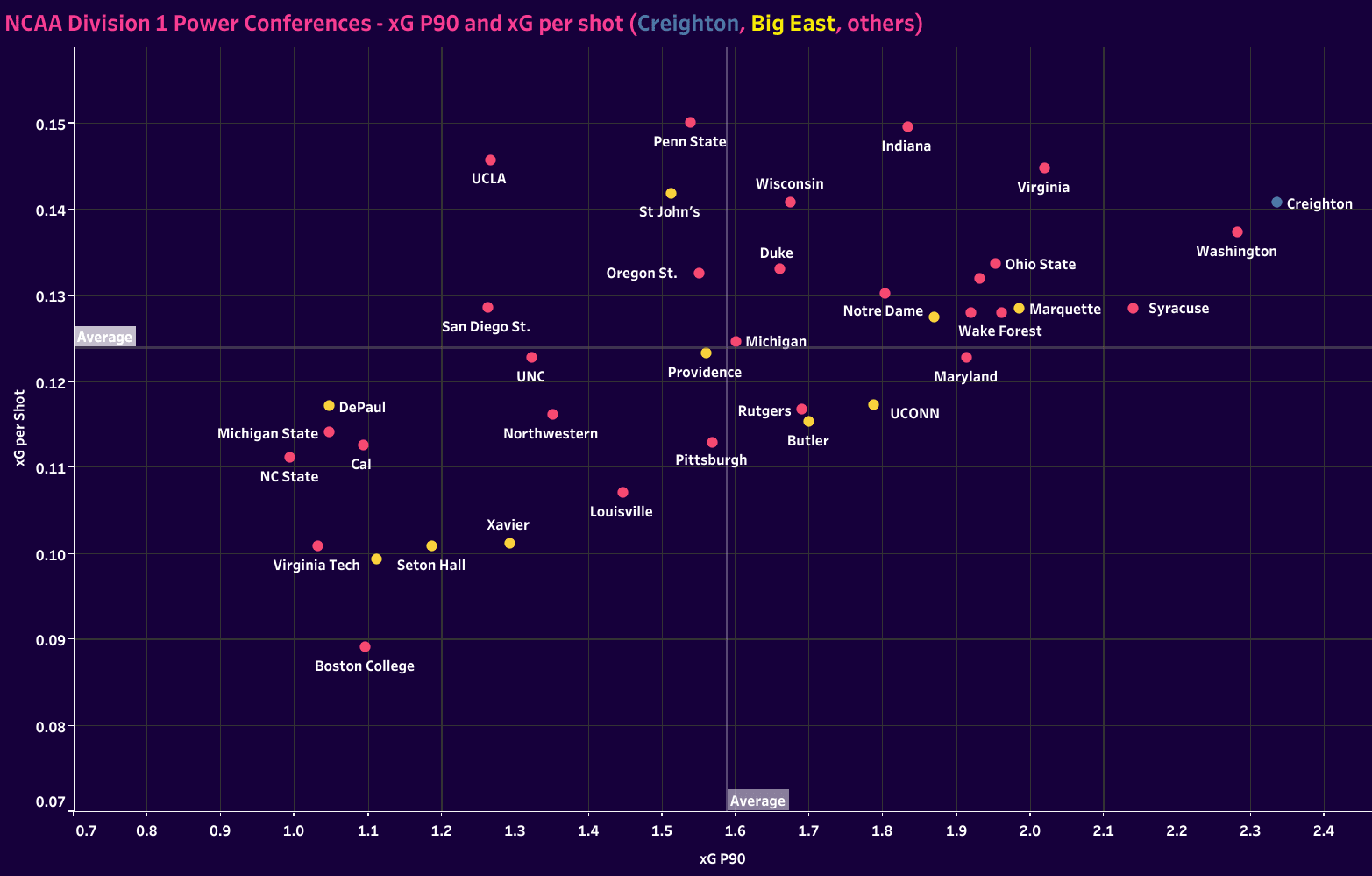
One of the common themes in 2022 was how willing Creighton was to pass up a low or moderate percentage shot for one of a higher quality. That Creighton team prioritised the quality of their goalscoring opportunities, whether that was making an extra pass or having the courage to take on that final defender who had no coverage behind him. Sarachan and Reynolds mentioned that framing shot selection in terms of xG per shot changed the way their players approached both shot selection and box entries.
Castro takes the spotlight once again, this time for his goal against DePaul University. As he dribbled up the pitch, he cleverly approached the box in a way that isolated him in a 1v1 situation with his defender. He cut inside as he approached the box and directed his course towards the nearest centreback. Our image has him at the start of his feint. He sells the shot well and gets both defenders to commit, then takes a touch around the overly aggressive outside back.
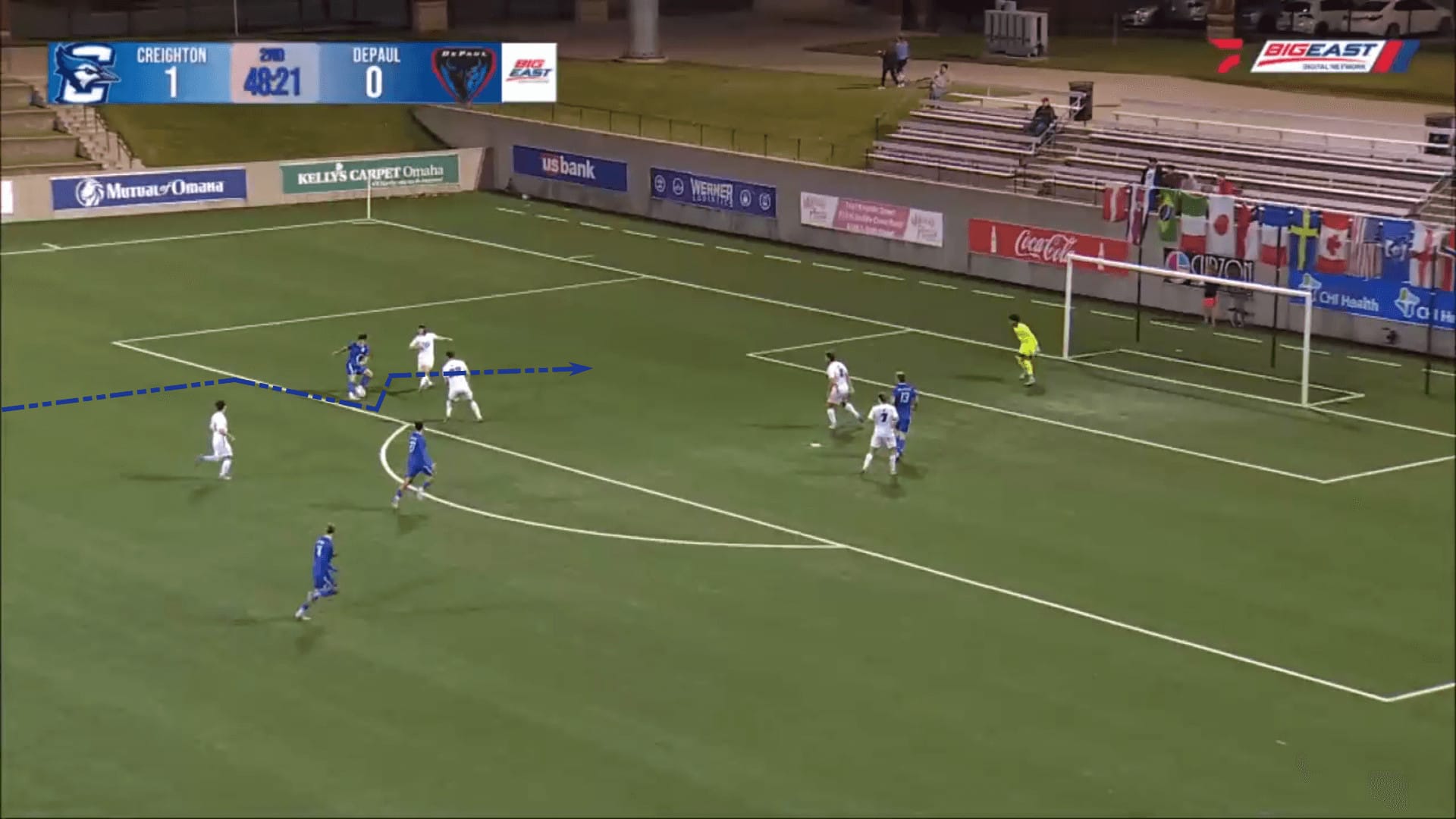
In passing up the first shooting opportunity, he was able to dribble eight yards deeper into the box and power his finish past the unprotected goalkeeper.
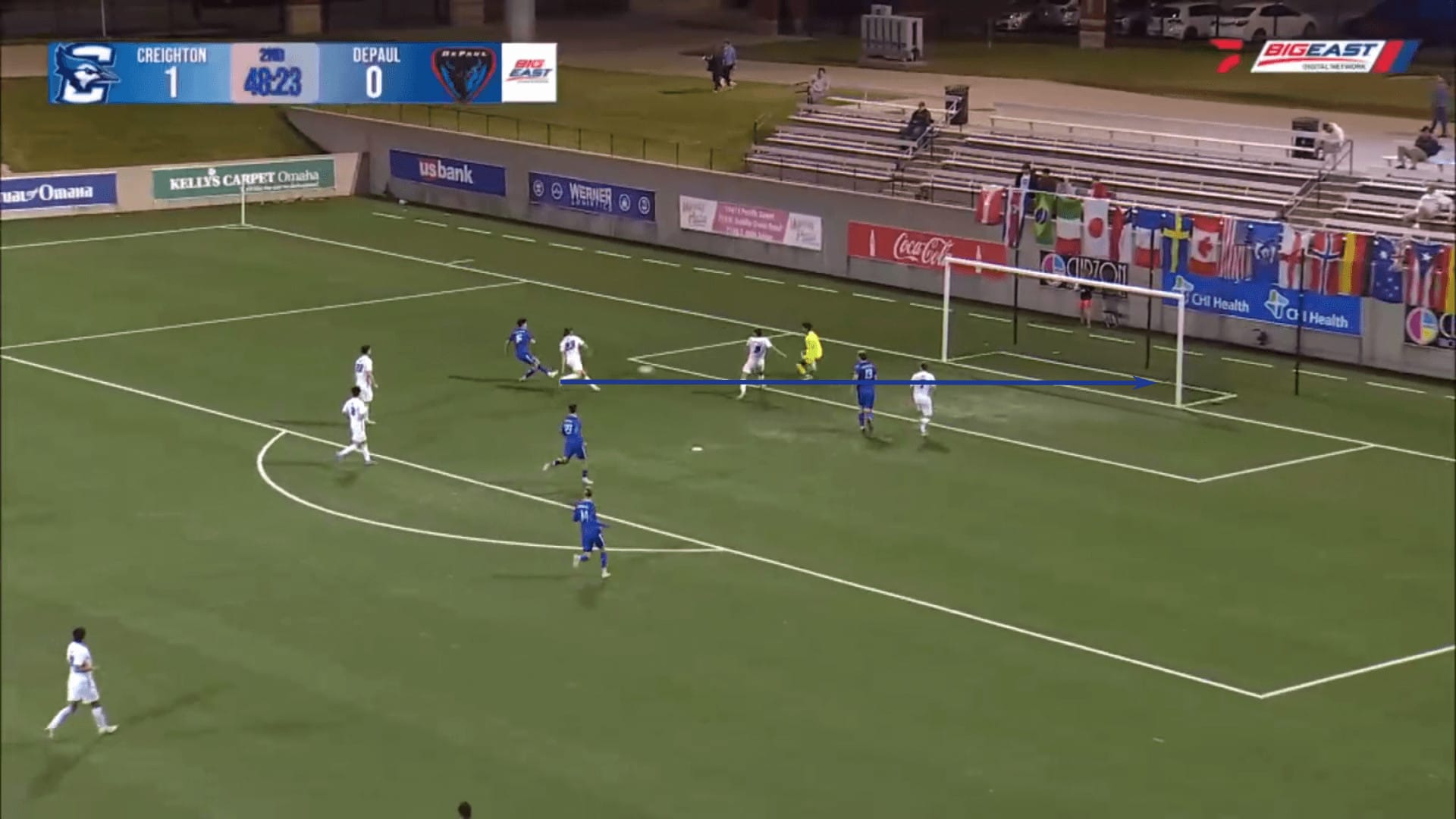
The team’s understanding of when to dribble in the box was a problem few opponents could solve. In the same situations where most teams would panic and settle for a lesser shot or hopeful cross, this Creighton side was willing to take a risk and push for higher-quality opportunities. That’s where a poacher like McGuire was so effective. His movement and timing in the box, coupled with an understanding of his teammates’ tendencies, were at the core of his breakout year.
This example against Oakland, the fifth goal of the game for Creighton, is a perfect example of this willingness to bide his time until his teammates were prepared to release the ball. The finish was simple, but it was the actions and understanding of tempo that led to the successful action.
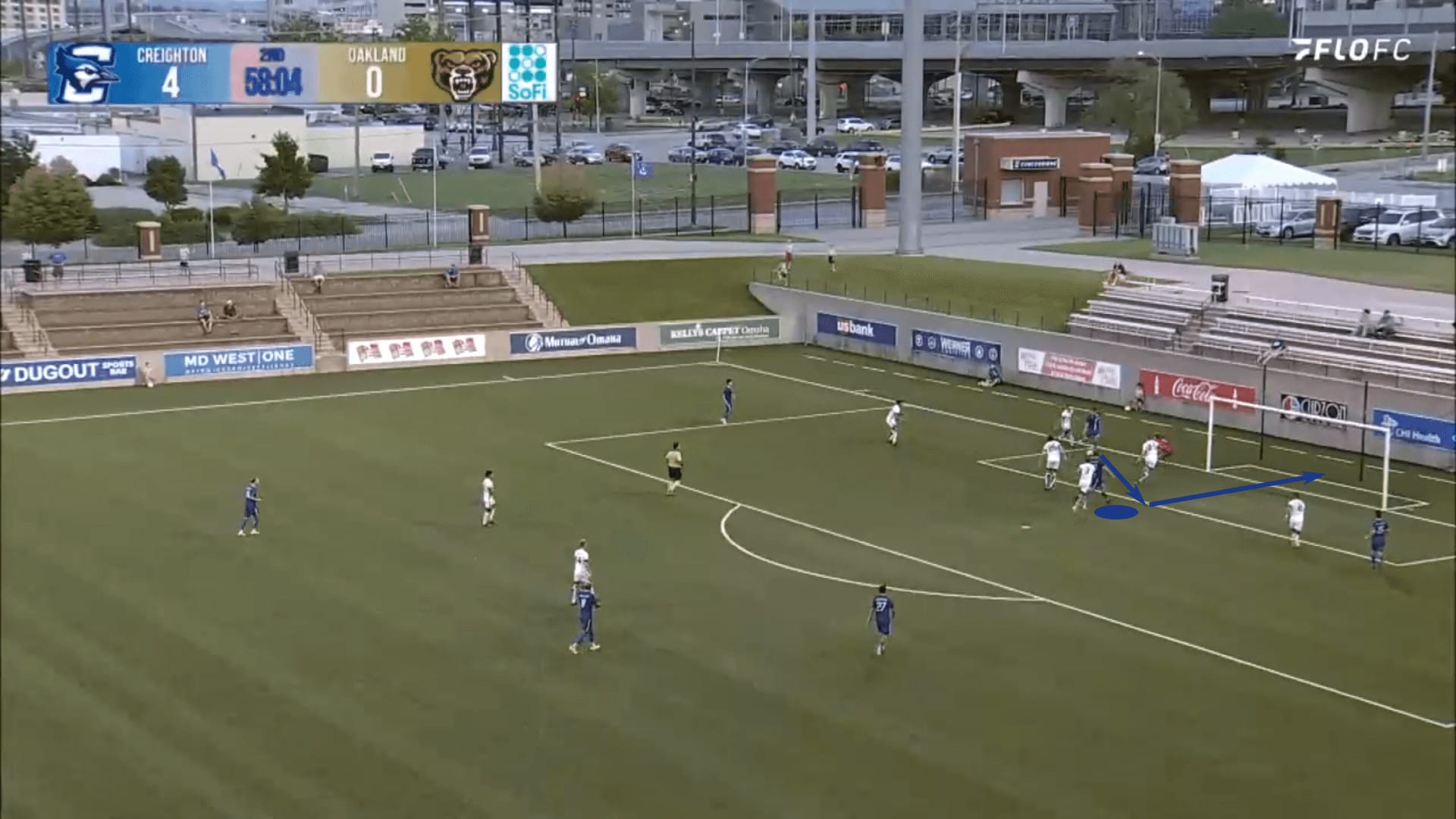
Creighton was also very willing to make the extra pass While the wingbacks had excellent 1v1 ability, the whole team simply had a good understanding of how to keep opponents off balance. The level of patience and intelligence required to carry out those tactics was a difference-maker in their season. Especially once they figured out how to stop conceding set-piece goals, the team had a profound belief that they could score against anyone at any time. The goals and results were always within reach.
In addition to shooting from better locations, it’s evident that there was a collective understanding that numbers were needed in the box, especially centrally, to create these high-value shooting opportunities. Creighton often expended the most energy in attack as they made the final push into the box. Whether from the forward line or a deep run from midfield, like this far post run from Maillet, trailing runners were always willing to push themselves physically to offer that additional option in the box.
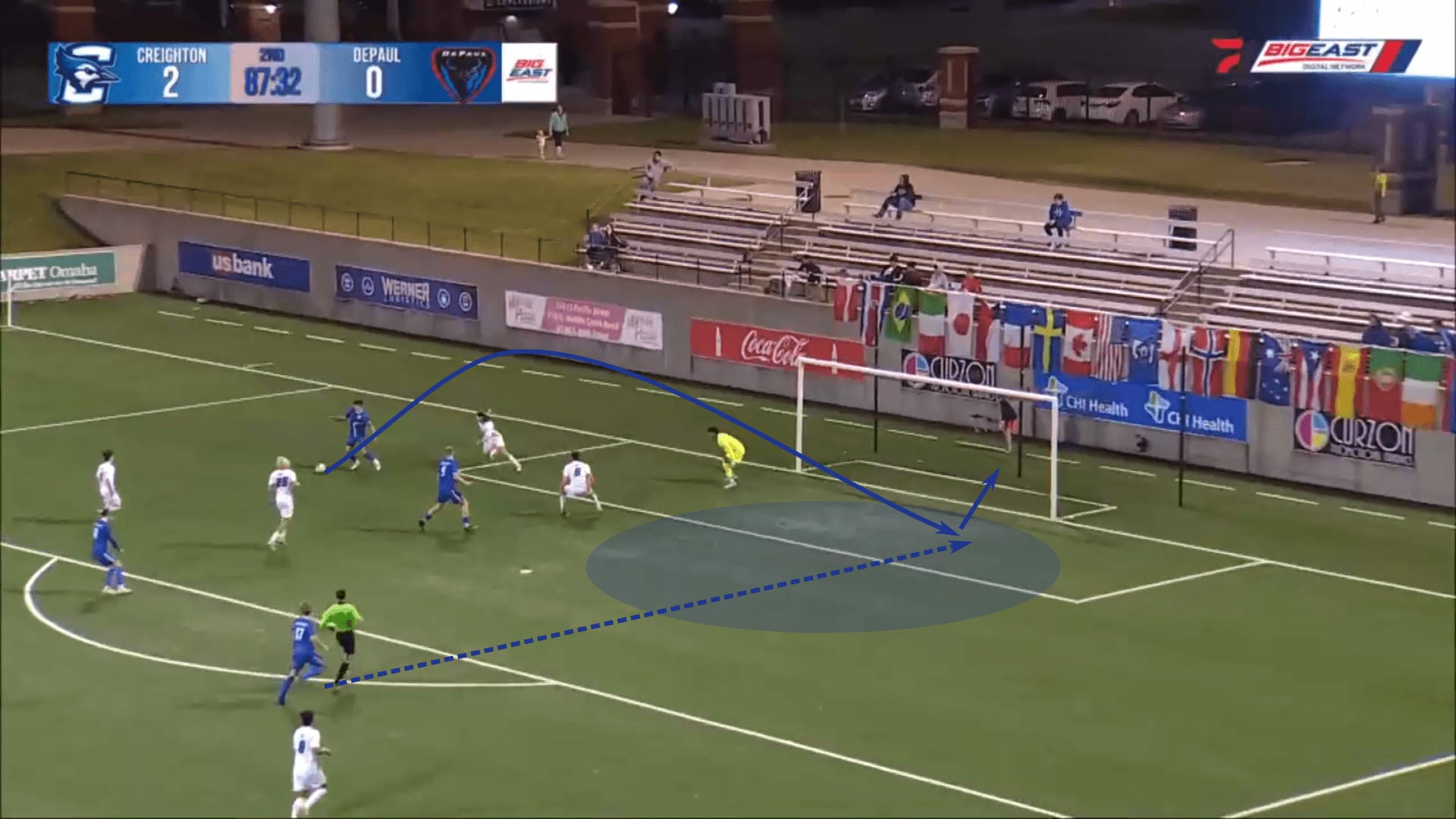
With the rise of xG, a concept like quantifying shot quality through xG per shot is a broad way to gauge the opportunities a team generates. From a coach’s perspective, it’s a valuable tool for preaching patience in the final third, developing a collective understanding of where to progress the attack (and enter the box) and reframing how your players think about shots.
This is precisely what the Creighton coaching staff did with xG. It was a learning tool that helped their players develop a better understanding of their collective objectives when attacking the opponent’s goal. Simple, yet such an effective tool when appropriately taught.
PPDA and high recoveries
“We want to have the ball as often as possible, so how do you do that? You have to win it back as quickly as possible. In terms of being against the ball, both in organised situations or in counterpressing situations, it (PPDA) was a good metric for the guys to see. Just always have the ball. Love the ball. If you love it when you have it, odds are you’re going to chase it when you don’t have it.” – Aidan Reynolds.
The tempo of NCAA college soccer is incredibly high. The lenient substitution rule, which limits players to no re-entry in the first half and one re-entry in the second, means that the players on the pitch are almost always fresh, especially for deep teams. A strong response in counterpressing situations is a necessity for success.
As Reynolds said, when you have the ball, take care of it and enjoy having it in your possession. When you don’t have it, the goal is to regain it quickly. This is where PPDA comes in. Creighton was one of the best counterpressing teams in the nation, averaging a PPDA of 7.76. They were also one of the national leaders in high recoveries P90, collecting 18.54 per P90.
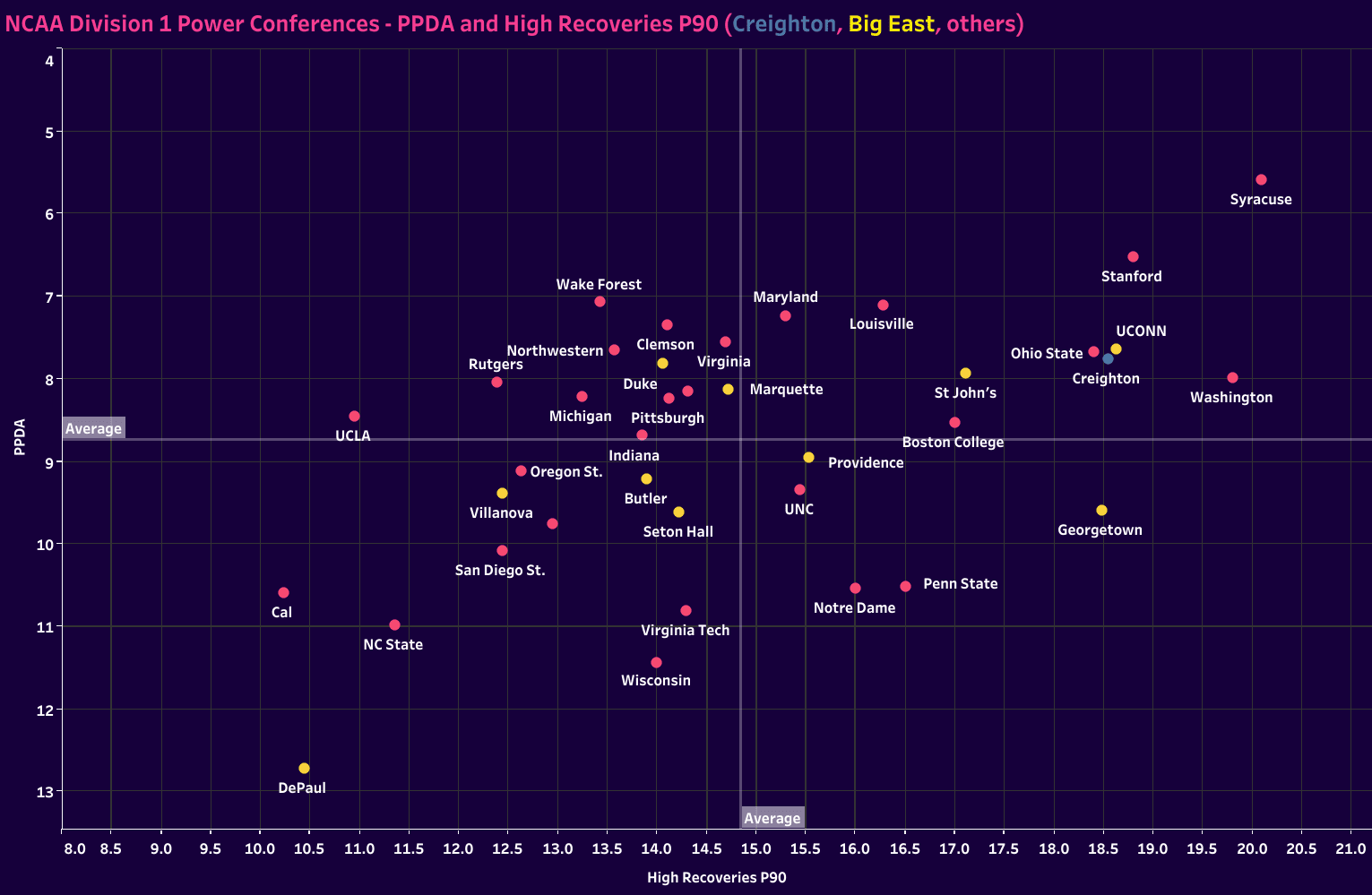
The objective behind the aggressive counterpress and high press was to determine the opposition’s attacking tempo. Taking that power out of the opponent’s hands forced them to play Creighton’s game. “It’s just going to increase the other team’s tempo. So we’re setting the tempo against the ball. With this Creighton team, they just understand that you never let anyone get in their rhythm,” said Reynolds.
While the Bluejays could change the tempo when in possession, the defensive tactics were a bit different — the higher the tempo, the better. Forcing opponents to play at the edge of their technical and tactical comfort zones was a tool for limiting the opposition’s success.
Their attacking tactics were designed to enable a strong counterpress. This example against Seton Hall gives a clear picture. Once the ball is lost, five Blue Jays are near the ball, both applying pressure on the first attacker and suffocating short and intermediate options.
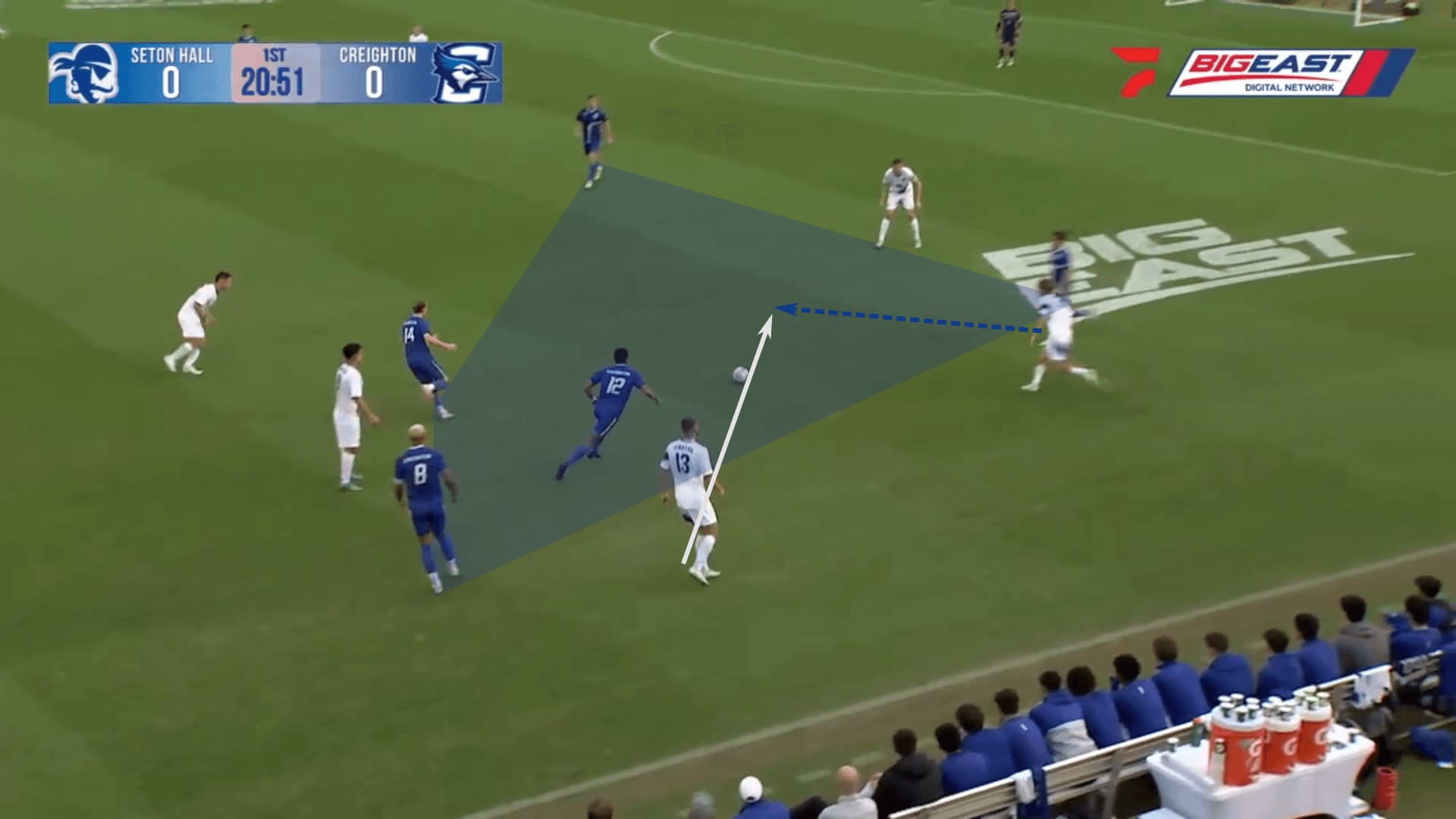
But the connection of defensive tactics to counterattacking opportunities went beyond counterpressing. This squad also used the high press to increase tempo and manufacture more direct attacks. That’s how they got their second goal against Seton Hall in the Big East tournament. After funnelling Seton Hall into the wing, Creighton took away the short options, cueing a pass on the ground down the line. But that pass never arrived at the target. Instead, it was blocked, trickling past the defender.
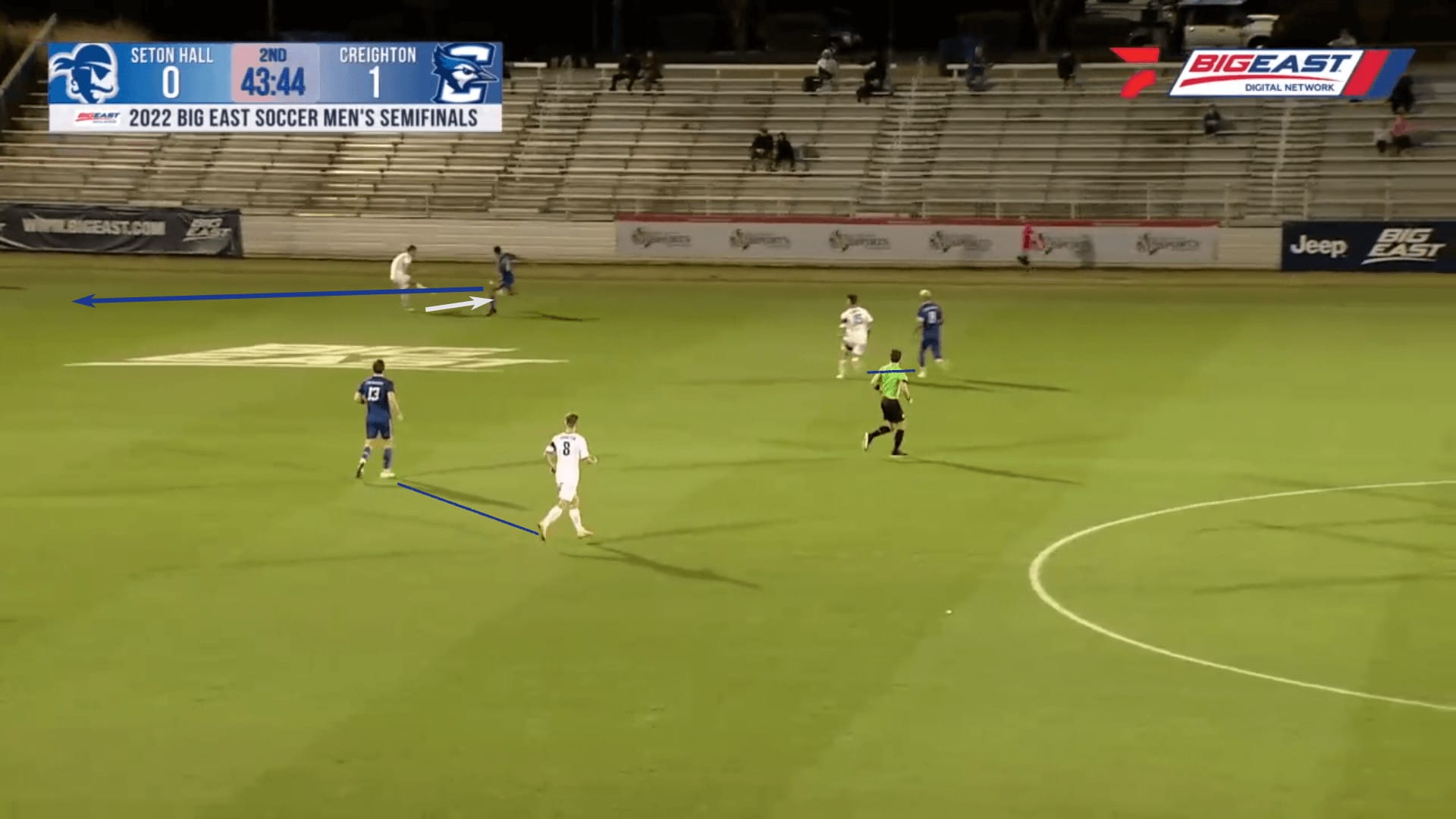
Centrally, it’s McGuire running into that central space. He would receive the pass and use a moment of brilliance to give Creighton an insurance goal. Much like Jürgen Klopp and Liverpool, the goal was to use the high press to generate more direct attacks on goal. Mission accomplished here.
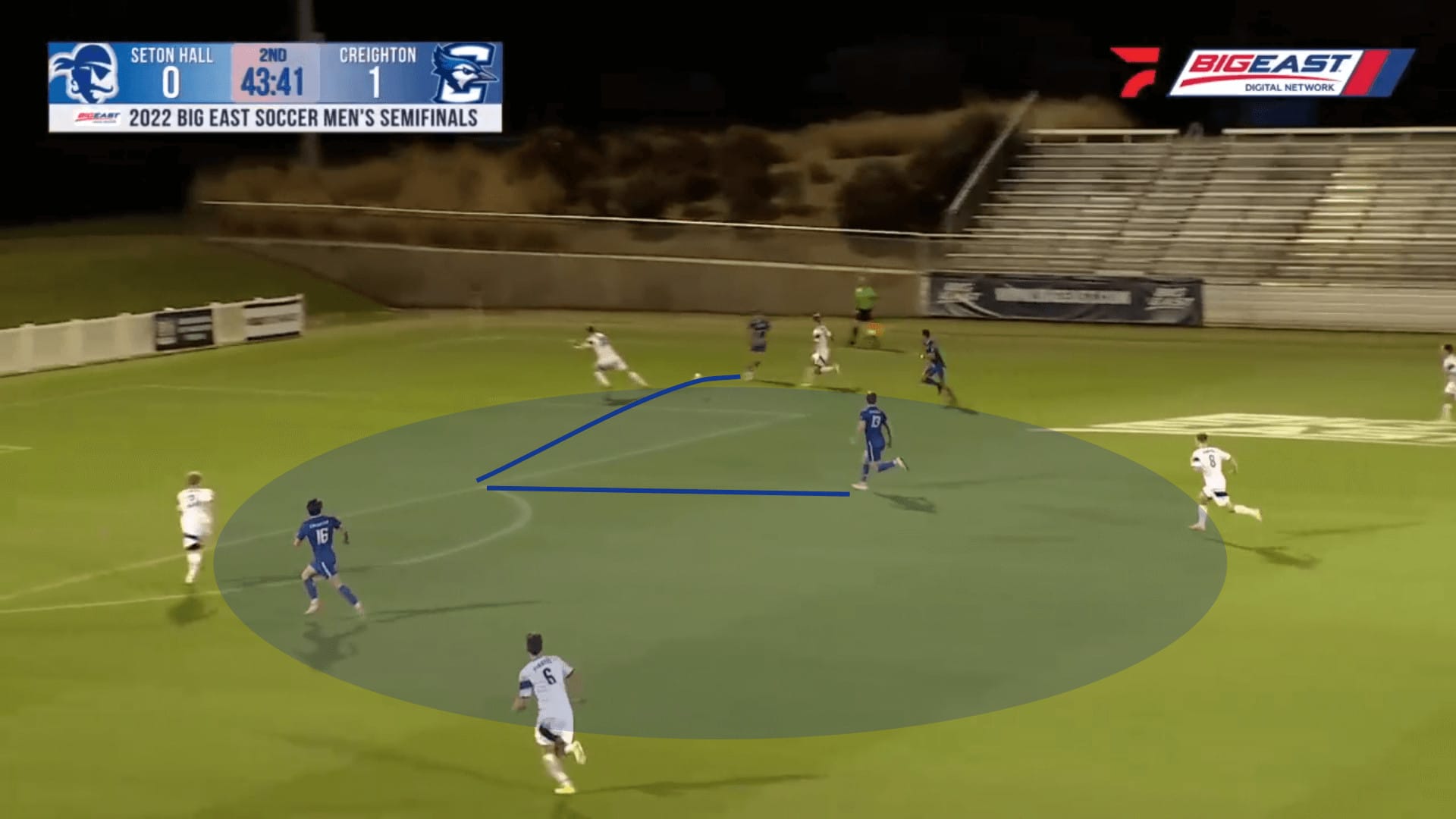
Creighton’s structure is conducive to more direct moves to goal, even in the high press. This example against Oakland, the final sequence of the section, shows how well connected their defensive shape corresponds to their intentions in attacking transitions. Right away, the first pass can go forward, and Creighton has enough numbers high up the pitch to produce a quality move towards goal.
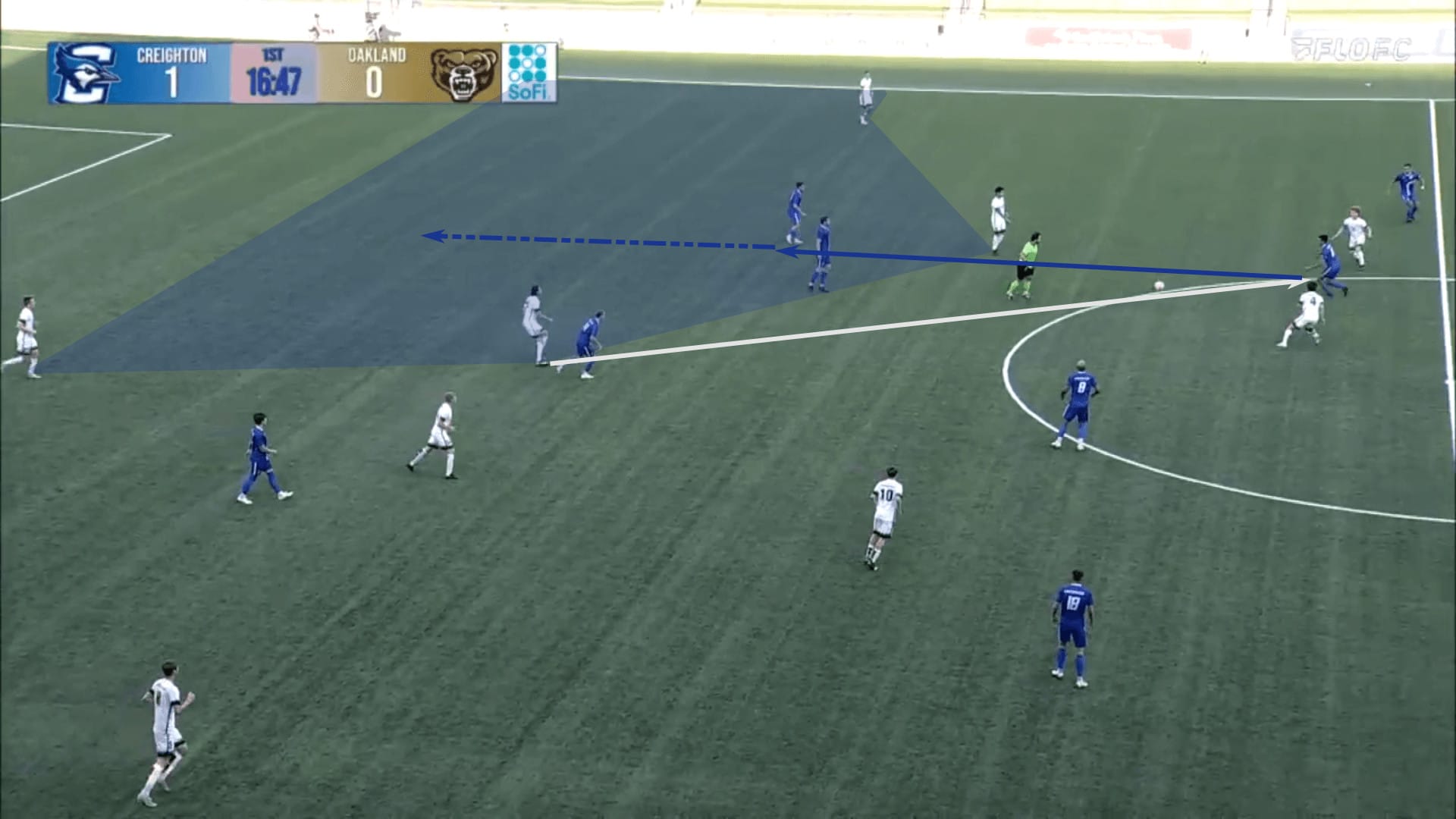
As they arrive in the box, it’s essentially a 3v2 with McGuire assisting Castro that produces the second goal.
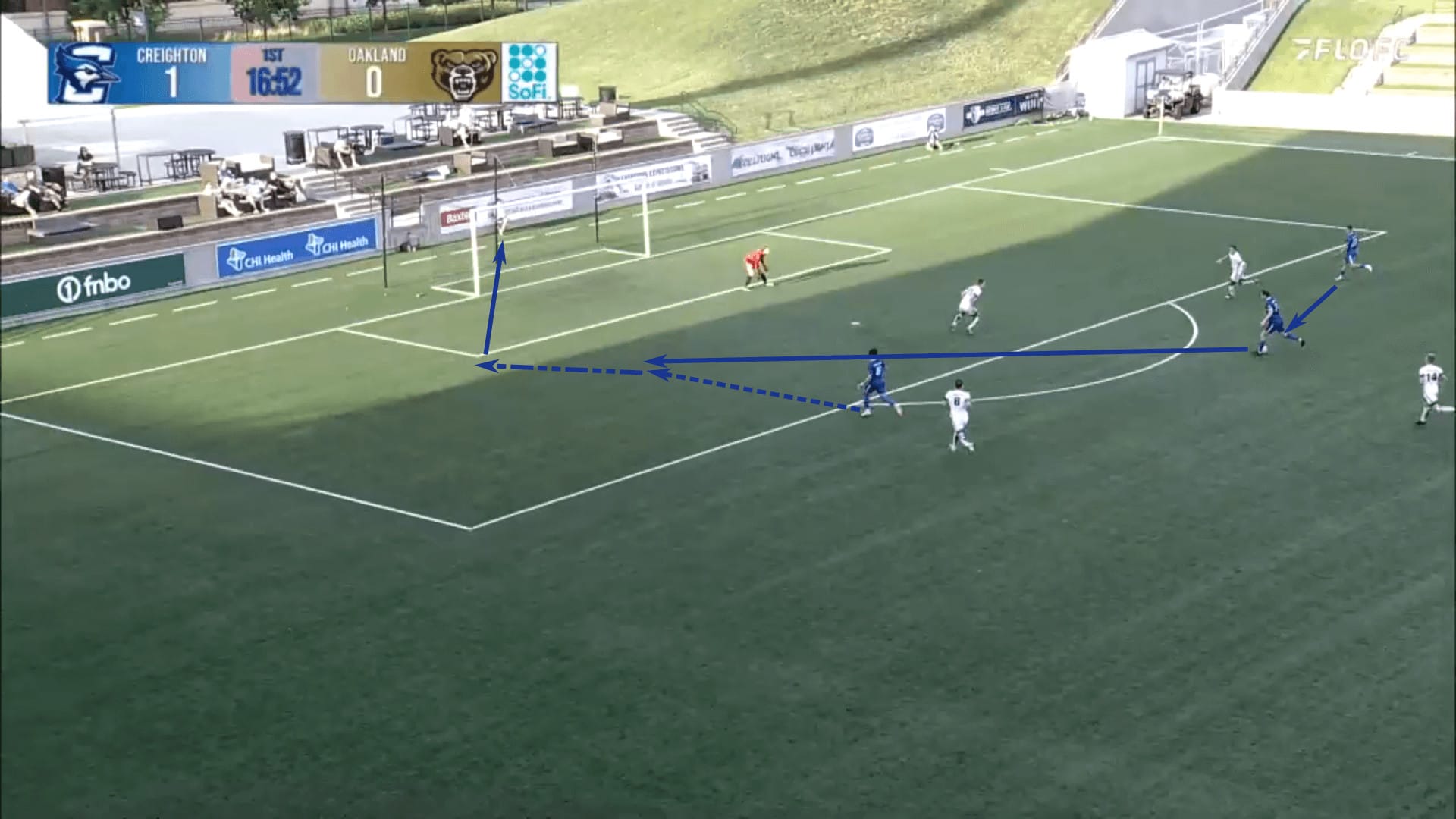
This is again where the coaching staff’s ability to connect the data to the on-field product convinced the players of the cause. The players knew that more direct attacks with limited passes and less time in possession typically produced the highest-quality scoring opportunities. However, the question that kept coming back to the coaching staff was, “How can we sustain 90 minutes of pressing?” That’s where Reynolds went back to the performance analysis data to show the players how the mathematics worked out:
“We started to see the correlation that there was actually less running. When we were pressing, it was these short bursts of winning the ball and having 25, 30, 35 yards to cover to get to the goal. When we were in more of a compact shape, like a mid-block or low-block, and this is from the three or four years of data we had, we saw they were doing more running side to side, going forward and back. Then when we were defending the goal and when you finally win the ball, you then have to attack 100 yards the other way, so there’s even more running added on. We showed the guys all this data, and they were like, ‘Okay, so we get to score more goals, run less, and we’re always going to have the ball?’ They were like, ‘All right.’ It was so simple to them.”
Shorter bursts, higher intensity and an aggressive pursuit of the ball. That’s Creighton’s defensive tactics in a nutshell. To the coaching staff’s credit, they found a way to measure the effectiveness of their defensive tactics, both in structured play and transition. Equally important, they helped their players see the connection between the statistics and the on-field product, including the physical load tied to different pressing tactics. That final step was showing the players how it benefited them. That’s the final kicker. That’s where the buy-in is secured.
Conclusion
Three core concepts and KPIs, one cohesive system. That’s the way Reynolds described Creighton’s project: “Those three things all connected into one. They weren’t separate from each other. You needed each thing. You need to be in the final third to create chances. You need to win the ball back to be in the final third to create chances.”
In speaking with Sarachan and Reynolds, the cohesion of Creighton’s data analysis project and the openness to implementing a system that is yet to make much headway in NCAA soccer stood out. The UNC women, led by legendary coach Anson Dorrance, are also known to have an extensive data analytics approach, primarily on the performance analytics side. However, the work at Creighton is a standout in the men’s game.
Throughout the conversation, Sarachan and Reynolds praised the willingness of the players to explore data analytics in NCAA soccer, as well as the buy-in from the squad. Even during difficult stretches in the season, the players held faith and continued to trust the process.
That trust came with a brave prediction from the coaching staff, one that reached fruition.
Reynolds, reminiscing on the brilliant season and accomplishment, shared that prediction. “We told the guys, ‘If you hit these metrics completely, we’ll win the Big East and be in the Final Four next year.’ I’ll never forget Charlie Auguste, who’s now with the Houston Dynamo; he came out of the locker room and said, ‘You should have said f***ing national champions.’”
This is the story of Creighton 2022, NCAA Division 1 national semi-finalists and a program that takes the math seriously.

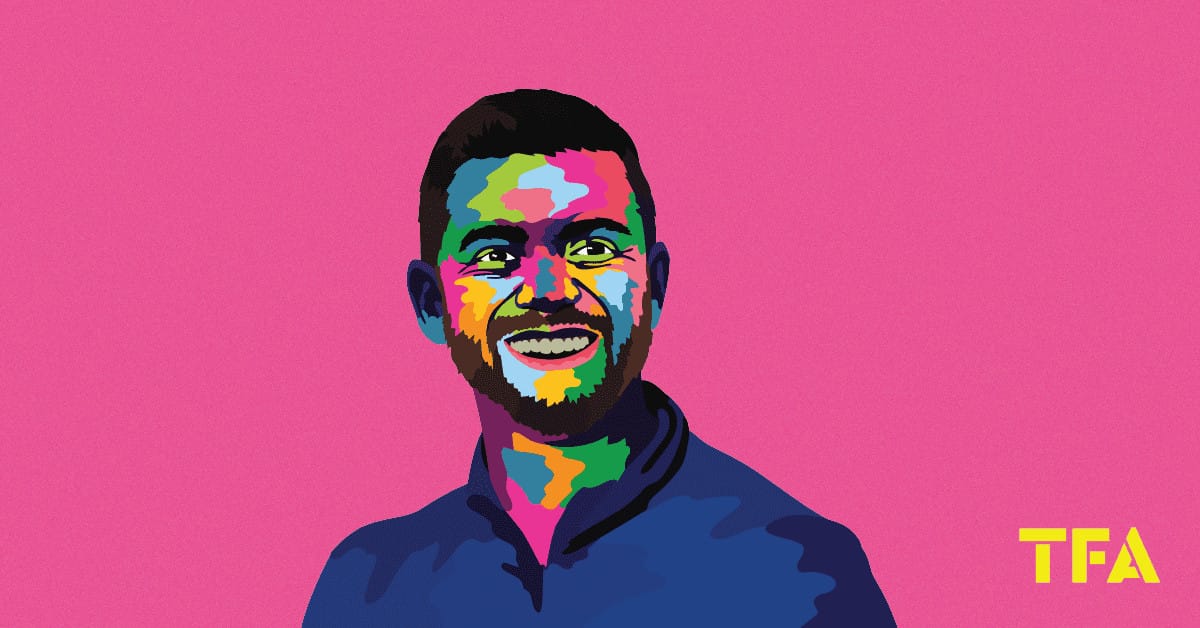


Comments